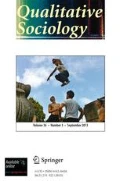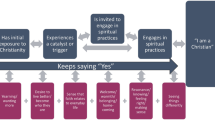Abstract
Most empirical studies of the conversion process have focused on individuals who have come to espouse the world view of a deviant religious denomination or sect. Using observational data our research analyzes the conversion process by which individuals come to identify with the ideology propounded by Alcoholics Anonymous (A.A.). A.A. provides prospective “alcoholics” with both a solution to drinking problems and an overarching world view with which to reinterpret their past experience. The A.A. conversion process can be divided into six phases: hitting bottom, first stepping, making a commitment, accepting your problem, telling your story, and doing Twelfth Step work. Each of these phases is described in detail. Similarities and differences are noted between the observed A.A. conversion process and the model generally described in the sociological literature on religious conversion. Our analysis indicates certain weaknesses in the process-model explanation of conversion and points to the necessity of taking into account organizational context and situational variables.
Similar content being viewed by others
References
Alcoholics Anonymous 1955 Alcoholics Anonymous: The Story of How Many Thousands of Men and Women Have Recovered from Alcoholism. New York: Alcoholics Anonymous World Services, Inc.
Austin, Ray 1977 “Empirical adequacy of Lofland's conversion model.” Review of Religious Research 18:282–87.
Balch, Robert W. and David Taylor 1978 “Seekers and saucers: The role of the cultic milieu in joining a UFO cult.” Pp. 43–64 in James T. Richardson (ed.), Conversion Careers: In and Out of the New Religions. Beverly Hills: Sage.
Baer, Hans 1978 “A field perspective of religious conversion: The Levites of Utah.” Review of Religious Research 19:279–294.
Bankston, William B., Craig J. Forsyth, and H. Hugh Floyd, Jr. 1981 “Toward a general mode of the process of radical conversion: An interactionist perspective on the transformation of self-identity.” Qualitative Sociology 4:279–297.
Becker, Howard S. 1958 “Problems of inference and proof in participant observation.” American Sociological Review 23:652–659.
—— 1960 “Notes on the concept of commitment.” American Journal of Sociology 66:32–40.
Bogdan, Robert 1972 Participant Observation in Organizational Settings. Syracuse, N.Y.: Syracuse University Press.
—— and Steven Taylor 1975 Introduction to Qualitative Research Methods. New York: Wiley-Interscience.
Bohince, E., and Orensteen 1953 “An evaluation of the services and programs of the Minneapolis chapter of Alcoholics Anonymous.” University of Minnesota. Masters of Arts Thesis, 1950. Abstract by V. Efron. Quarterly Journal of Studies on Alcohol 14:131–32.
Boyanowsky, E. O. 1977 “The psychology of identity change: A theoretical framework for review and analysis of the self-role transformation process.” Canadian Psychological Review 18:115–127.
Bromley, David G. and Anson D. Shupe, Jr. 1979 “Moonies” in America: Cult, Church and Crusade. Beverly Hills: Sage.
Eister, Allan 1950 Drawing Room Conversion. Durham: Duke University Press.
Gellman, Irving P. 1964 The Sober Alcoholic: An Organizational Analysis of Alcoholics Anonymous. New Haven: College and University Press.
Gerlach, Luther P. and Virginia Hine 1968 “Five factors crucial to the growth and spread of a modern religious movement.” Journal for the Scientific Study of Religion 7:23–40.
—— 1970 People, Power, Change: Movements of Social Transformation. Indianapolis: Bobbs-Merrill.
Glaser, Barney and Anselm Strauss 1967 The Discovery of Grounded Theory: Strategies for Qualitative Research. Chicago: Aldine.
Greil, Arthur L. 1977 “Previous dispositions and conversion to the perspectives of social and religious movements.” Sociological Analysis 38:115–25.
-- and David R. Rudy 1981 “What do we know about the conversion process?” Paper presented at the annual meeting of The Society for the Scientific Study of Religion.
Hanfmann, Eugenia 1951 “The life history of an ex-alcoholic: With an evaluation of factors involved in causation and rehabilitation.” Quarterly Journal of Studies on Alcohol 12:405–443.
Harder, Mary, James T. Richardson, and Robert B. Simmonds 1972 “Jesus people.” Psychology Today 6:45–50; 110–113.
Harrison, Michael 1974a “Sources of recruitment to Catholic Pentacostalism.” Journal for the Scientific Study of Religion 13:49–64.
—— 1974b “Preparation for life in the spirit: The process of initial commitment to a religious movement.” Urban Life and Culture 2:387–414.
Heirich, Max 1977 “Change of heart: A test of some widely held theories about religious conversion.” American Journal of Sociology 83:653–80.
Hine, Virginia 1970 “Bridge burners: Commitment and participation in a religious movement.” Sociological Analysis 31:61–66.
Jackson, Joan K. and Ralph Conner 1953 “Attitudes of the parents of alcoholics, moderate drinkers, and nondrinkers toward drinking.” Quarterly Journal of Studies on Alcohol 14:596–613.
James, William 1961 The Varieties of Religious Experience. London: Collier.
Jones, Robert Kenneth 1970 “Sectarian characteristics of Alcoholics Anonymous.” Sociology 4:181–195.
Kanter, Rosabeth Moss 1972 Commitment and Community: Communes and Utopias in Sociological Perspective. Cambridge: Harvard University Press.
Laslett, Barbara and Carol A. B. Warren 1975 “Losing weight: The organizational promotion of behavior change.” Social Problems 23:69–80.
Lifton, Robert Jay 1963 Thought Reforms and the Psychology of Totalism. New York: Norton.
Lofland, John 1966 Doomsday Cult. Englewood Cliffs, N.J.: Prentice Hall.
—— 1969 Deviance and Identity. Englewood Cliffs, N.J.: Prentice Hall.
—— 1978 “Becoming a world-saver revisited.” Pp. 10–23 in James T. Richardson (ed.), Conversion Careers: In and Out of the New Religions. Beverly Hills: Sage.
—— and Rodney Stark 1965 “Becoming a world-saver: A theory of conversion to a deviant perspective.” American Sociological Review 30:862–74.
Lynch, Frederick R. 1978 “Toward a theory of conversion and commitment to the occult.” Pp. 91–112 in James T. Richardson, Conversion Careers: In and Out of the New Religions. Beverly Hills: Sage.
Parrucci, D. J. 1968 “Religious conversion: A theory of deviant behavior.” Sociological Analysis 29:144–154.
Patrick, Ted and Tom Dulack 1976 Let Our Children Go. New York: Ballantine.
Petrunik, Michael G. 1972 “Seeing the light: A study of conversion to alcoholics anonymous.” Journal of Voluntary Action Research 1:30–38.
Richardson, James T. (ed.) 1978 Conversion Careers: In and Out of the New Religions. Beverly Hills: Sage.
—— 1980 Conversion careers.” Society 17:47–50.
—— and Mary Stewart 1978 “Conversion process models and the Jesus movement.” Pp. 24–42 in James T. Richardson (ed.), Conversion Careers: In and Out of the New Religions. Beverly Hills: Sage.
——, —— and Robert B. Simmonds 1978 “Conversion to fundamentalism.” Society 15:46–52.
—— 1979 Organized Miracles: A Study of a Contemporary, Youth Communal, Fundamentalist Organization. New Brunswick, N.J.: Transaction.
Robinson, David 1979 Talking Out of Alcoholism. The Self-Help Process of Alcoholics Anonymous. Baltimore: University Park Press.
Rudy, David R. 1978 “A typology of alcoholic careers.” Paper presented at the annual meeting of the Society for the Study of Social Problems.
Sarbin, Theodore R. and Nathan Adler 1970 “Self-reconstitution processes: A preliminary report.” Psychoanalytic Review 57:609–616.
Schein, Edgar 1961 Coercive Persuasion. New York: Norton.
Schwartz, Howard and Jerry Jacobs 1979 Qualitative Sociology: A Method to the Madness. New York: The Free Press.
Seggar, J. and P. Kunz 1972 “Conversion: Evaluation of a step-like process for problem solving.” Review of Religious Research 13:178–84.
Shupe, Anson D., Roger Spielman, and Sam Stigall 1977 “Deprogramming: The new exorcism.” American Behavioral Scientist 20:941–56.
Snow, David A. and Cynthia L. Phillips 1980 “The Lofland-Stark conversion model: A critical reassessment.” Social Problems 27:430–447.
——, Louis A. Zurcher and Sheldon Eckland-Olson 1980 “Social networks and social movements: A microstructural approach to differential recruitment.” American Sociological Review 45:787–801.
Stark, Rodney and William Sims Bainbridge 1980 “Networks of faith: Interpersonal bonds and recruitment to cults and sects.” American Journal of Sociology 85:1376–1395.
Straus, Roger A. 1976 “Changing oneself: Seekers and the creative transformation of life experiences.” Pp. 252–272 in John Lofland, Doing Social Life. New York: Wiley.
—— 1979 “Religious conversion as a personal and collective accomplishment.” Sociological Analysis 40:158–165.
Toch, Hans 1965 The Social Psychology of Social Movements. New York: Bobbs-Merrill.
Travisano, Richard V. 1970 “Alternation and conversion as qualitatively different transformations.” Pp. 594–606 in Gregory P. Stone and Harvey A. Farberman, Social Psychology Through Symbolic Interaction. Waltham, MA.: Xerox.
Trice, Harrison 1957 “A study of the process of affiliation with A.A.” Quarterly Journal of Studies on Alcohol 18:39–54.
—— and Paul M. Roman 1970 “Delabeling, relabeling and Alcoholics Anonymous.” Social Problems 17:538–546.
Wilson, John 1978 Religion in American Society: The Effective Presence. Englewood Cliffs, N.J.: Prentice Hall.
Author information
Authors and Affiliations
Rights and permissions
About this article
Cite this article
Greil, A.L., Rudy, D.R. Conversion to the world view of Alcoholics Anonymous: A refinement of conversion theory. Qual Sociol 6, 5–28 (1983). https://doi.org/10.1007/BF00987195
Issue Date:
DOI: https://doi.org/10.1007/BF00987195




